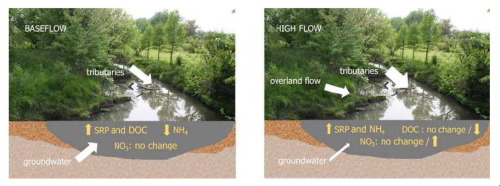当前位置:
X-MOL 学术
›
J. Hydrol.
›
论文详情
Our official English website, www.x-mol.net, welcomes your
feedback! (Note: you will need to create a separate account there.)
Retention and release of nutrients and dissolved organic carbon in a nutrient-rich stream: a mass balance approach
Journal of Hydrology ( IF 5.9 ) Pub Date : 2018-11-01 , DOI: 10.1016/j.jhydrol.2018.09.051 Claudia Feijoó , María Laura Messetta , Cecilia Hegoburu , Alicia Gómez Vázquez , José Guerra-López , Josep Mas-Pla , Laura Rigacci , Victoria García , Andrea Butturini
Journal of Hydrology ( IF 5.9 ) Pub Date : 2018-11-01 , DOI: 10.1016/j.jhydrol.2018.09.051 Claudia Feijoó , María Laura Messetta , Cecilia Hegoburu , Alicia Gómez Vázquez , José Guerra-López , Josep Mas-Pla , Laura Rigacci , Victoria García , Andrea Butturini

|
Abstract The relevance of fluvial systems to process nutrients and carbon is widely accepted, but their role as sinks and sources of nutrients and dissolved organic carbon (DOC) is still under discussion especially in non-forested and highly productive streams. In this study, we used a mass balance approach at a reach scale in a Pampean stream to elucidate the major sources of water, nutrients and DOC as well as to determine net in-stream retention efficiencies of nutrients and DOC under different hydrological conditions. We measured conductivity, conservative ions (chloride and calcium), soluble reactive phosphorus (SRP), nitrate (NO3), nitrite (NO2), ammonium (NH4) and DOC at the end-point of a reach of Las Flores stream (site A), at two upstream tributaries (B1 and B2), and at each potential hydrological contributors to stream flow (groundwater, overland and subsurface flows, and rainfall). In addition, we monitored one storm event where we collected samples during the rising and the recession limb of the hydrograph. Stream flow originated from groundwater (≈50%), upstream tributaries (B1 and B2) at baseflow, whereas overland flow contributed >20% during high flows. During baseflow, groundwater provided NO3 to stream water, while B2, which received a point input of a dairy industry, was the main source of SRP and NH4. Conversely, SRP and NH4 were provided by B1, overland flow and subsurface flow during high flows. Overland flow also contributed DOC during high flow periods. Mass balance estimates revealed that the reach acts as a source of DOC, SRP and NO3 (21.4, 37.4 and 53.5% mean net in-stream release, respectively) and a sink of NH4 (−36.8% mean net in-stream retention). Relevant in-stream processes may be nutrient uptake (as in the case of SRP and NH4) and biotic production (DOC), as well as decomposition (SRP) and nitrification (NH4) in this Pampean stream. Our results stress the relevance of nutrient and DOC generation processes within the channel in non-forested and highly productive streams.
中文翻译:

富营养流中养分和溶解有机碳的保留和释放:质量平衡方法
摘要 河流系统与处理养分和碳的相关性已被广泛接受,但它们作为养分和溶解有机碳 (DOC) 的汇和来源的作用仍在讨论中,尤其是在非森林和高产溪流中。在这项研究中,我们在 Pampean 河流中的河段尺度上使用质量平衡方法来阐明水、养分和 DOC 的主要来源,并确定不同水文条件下养分和 DOC 的净河内滞留效率。我们在 Las Flores 河段(地点 A)的终点测量了电导率、保守离子(氯离子和钙)、可溶性活性磷(SRP)、硝酸盐(NO3)、亚硝酸盐(NO2)、铵(NH4)和 DOC ),在两个上游支流(B1 和 B2),以及在每个潜在的水文贡献者河流流量(地下水,陆上和地下流动,以及降雨)。此外,我们还监测了一个风暴事件,在该事件中我们在水文过程线的上升和下降段收集了样本。溪流源自地下水 (≈50%),基流的上游支流 (B1 和 B2),而在高流量期间,地表流贡献了 >20%。在基流期间,地下水为河流水提供 NO3,而接受乳制品行业点输入的 B2 是 SRP 和 NH4 的主要来源。相反,在高流量期间,SRP 和 NH4 由 B1、地表流和地下流提供。在高流量期间,地表流量也贡献了 DOC。质量平衡估计表明,该河段是 DOC、SRP 和 NO3(分别为 21.4、37.4 和 53.5% 的平均净流中释放)和 NH4 的汇(-36.8% 平均净流中保留)的来源。相关的河内过程可能是养分吸收(如 SRP 和 NH4 的情况)和生物生产 (DOC),以及该 Pampean 河流中的分解 (SRP) 和硝化 (NH4)。我们的结果强调了非森林和高产溪流中渠道内养分和 DOC 生成过程的相关性。
更新日期:2018-11-01
中文翻译:

富营养流中养分和溶解有机碳的保留和释放:质量平衡方法
摘要 河流系统与处理养分和碳的相关性已被广泛接受,但它们作为养分和溶解有机碳 (DOC) 的汇和来源的作用仍在讨论中,尤其是在非森林和高产溪流中。在这项研究中,我们在 Pampean 河流中的河段尺度上使用质量平衡方法来阐明水、养分和 DOC 的主要来源,并确定不同水文条件下养分和 DOC 的净河内滞留效率。我们在 Las Flores 河段(地点 A)的终点测量了电导率、保守离子(氯离子和钙)、可溶性活性磷(SRP)、硝酸盐(NO3)、亚硝酸盐(NO2)、铵(NH4)和 DOC ),在两个上游支流(B1 和 B2),以及在每个潜在的水文贡献者河流流量(地下水,陆上和地下流动,以及降雨)。此外,我们还监测了一个风暴事件,在该事件中我们在水文过程线的上升和下降段收集了样本。溪流源自地下水 (≈50%),基流的上游支流 (B1 和 B2),而在高流量期间,地表流贡献了 >20%。在基流期间,地下水为河流水提供 NO3,而接受乳制品行业点输入的 B2 是 SRP 和 NH4 的主要来源。相反,在高流量期间,SRP 和 NH4 由 B1、地表流和地下流提供。在高流量期间,地表流量也贡献了 DOC。质量平衡估计表明,该河段是 DOC、SRP 和 NO3(分别为 21.4、37.4 和 53.5% 的平均净流中释放)和 NH4 的汇(-36.8% 平均净流中保留)的来源。相关的河内过程可能是养分吸收(如 SRP 和 NH4 的情况)和生物生产 (DOC),以及该 Pampean 河流中的分解 (SRP) 和硝化 (NH4)。我们的结果强调了非森林和高产溪流中渠道内养分和 DOC 生成过程的相关性。











































 京公网安备 11010802027423号
京公网安备 11010802027423号